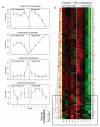Effective treatment of psoriasis with etanercept is linked to suppression of IL-17 signaling, not immediate response TNF genes
- PMID: 19895991
- PMCID: PMC2852188
- DOI: 10.1016/j.jaci.2009.08.046
Effective treatment of psoriasis with etanercept is linked to suppression of IL-17 signaling, not immediate response TNF genes
Abstract
Background: TNF inhibitors have revolutionized the treatment of psoriasis vulgaris as well as psoriatic and rheumatoid arthritis and Crohn disease. Despite our understanding that these agents block TNF, their complex mechanism of action in disease resolution is still unclear.
Objective: To analyze globally the genomic effects of TNF inhibition in patients with psoriasis, and to compare genomic profiles of patients who responded or did not respond to treatment.
Methods: In a clinical trial using etanercept TNF inhibitor to treat psoriasis vulgaris (n = 15), Affymetrix gene arrays were used to analyze gene profiles in lesional skin at multiple time points during drug treatment (baseline and weeks 1, 2, 4, and 12) compared with nonlesional skin. Patients were stratified as responders (n = 11) or nonresponders (n = 4) on the basis of histologic disease resolution. Cluster analysis was used to define gene sets that were modulated with similar magnitude and velocity over time.
Results: In responders, 4 clusters of downregulated genes and 3 clusters of upregulated genes were identified. Genes downmodulated most rapidly reflected direct inhibition of myeloid lineage immune genes. Upregulated genes included the stable dendritic cell population genes CD1c and CD207 (langerin). Comparison of responders and nonresponders revealed rapid downmodulation of innate IL-1beta and IL-8 sepsis cascade cytokines in both groups, but only responders downregulated IL-17 pathway genes to baseline levels.
Conclusion: Although both responders and nonresponders to etanercept inactivated sepsis cascade cytokines, response to etanercept is dependent on inactivation of myeloid dendritic cell genes and inactivation of the T(H)17 immune response.
Figures





References
Publication types
MeSH terms
Substances
Grants and funding
LinkOut - more resources
Full Text Sources
Other Literature Sources
Medical
Molecular Biology Databases

